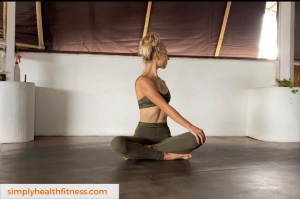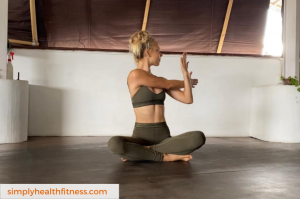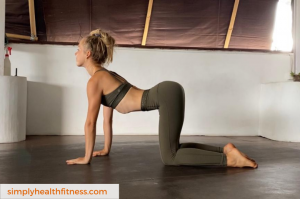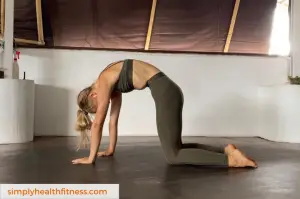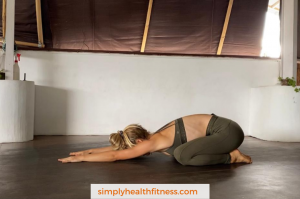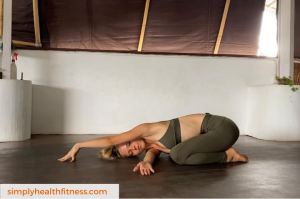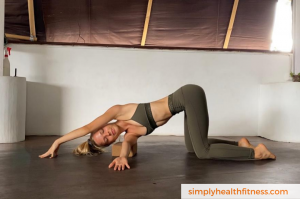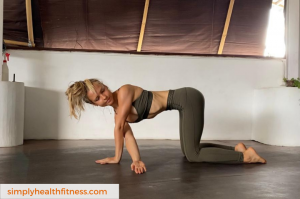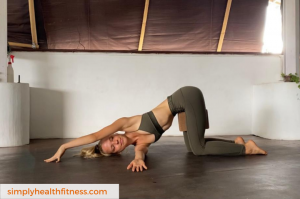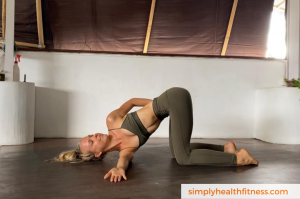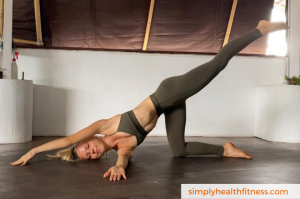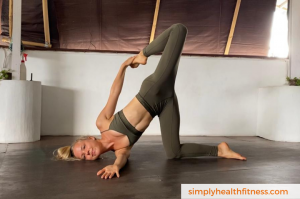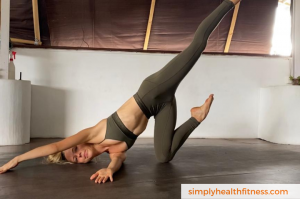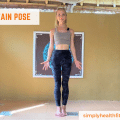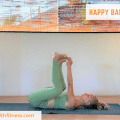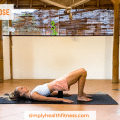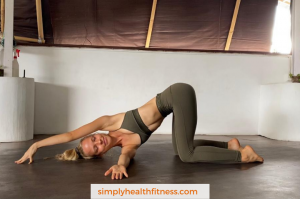
Thread the needle pose in yoga is a beginner-friendly asana that is most commonly done in slower paced yoga sequences.
In Sanskrit, it is known as “Urdhva Mukha Pasasana,” which translates to “upward facing twist.” As the name describes, this asana is a gentle twist and can release tension in the back, shoulders, and neck.
Therefore, if you struggle with shoulder tension, spinal stiffness, and/or neck issues, this can be a good pose for you to try.
There are variations to this pose to make it more or less advanced and adaptable to your body’s needs, and this article will explore the benefits you can receive from practicing thread the needle pose and how to perform it properly and safely.
Preparatory Poses
Cross Legged Twist
This pose will warm up the spine and prepare it for the twist in thread the needle. Sit in a cross legged position with both sitting bones weighted equally on the mat.
Relax your shoulders, lengthen your spine, and take your right hand to your left knee. Take 5 breaths here on each side.
Shoulder Stretch with Twist
The added twist in this stretch will help you lower your head completely during thread the needle. Take your right arm across your chest and your left arm hooking underneath, pulling towards you.
Twist to the right while keeping an equal weight in your sitting bones. Take 5 breaths and repeat on the opposite side.
Cat and Cow
Flowing between these two positions will give mobility to the spine to release your joints and prepare to twist safely.
From tabletop position, enter cow pose by dropping your belly towards the floor and arching your back on an inhale.
On your exhale, curl your spine and upper back towards the sky and squeeze your belly in for cat pose. Repeat 5 times.
Child’s Pose
This pose will gently open your shoulders and lengthen your spine before entering thread the needle pose.
From tabletop, open your knees wider and sink your hips back onto your heels. With your palms facing down, reach your arms forward and rest your head on the mat. Rest here for 5-10 breaths.
How to do Thread the Needle Pose
- The starting position is tabletop, so place your wrists directly under your shoulders and knees under your hips with an equal weight throughout. Keep your hips and shoulders squared and maintain your spine in its neutral position.
- Starting with your right arm, lift your right hand up to the sky as you open your chest to right side of the mat.
- With your straight arm, take your right hand and “thread” your right arm underneath you to the left side.
- Rest your right shoulder and ear on the mat, and keep your right palm facing upwards.
- Gaze to the left and walk your left palm forward to lengthen it.
- Take 5-10 breaths in this position.
- To exit safely, walk your left palm back directly under your left shoulder and press it to lift your right arm back up. Keep your chest open as you stretch your right arm up to the sky. Return to table top and repeat on the other side.

The Key Joints and Muscles Involved
Shoulder Joint
This is a very delicate joint, where chronic shoulder pain can develop if you tire it or perform exercises incorrectly.
It is a ball and socket joint located between the upper arms and shoulder blades.
Stiffness in this area will only create compensation in the body and can cause pain in other areas. The stretch from thread the needle pose increases the mobility in the joint, which will ease movement as well as help prevent injuries.
Spinal Joints
The joints throughout the spine are incredibly important in maintaining the form and function of our entire body.
Performing stretches and twists, such as thread the needle, as well as many other yoga poses, the joints will stay lubricated and flexible.
Tension in the spine causes pain, back injuries, and worsens your posture, which also has negative effects on your physical and mental well being.
Neck Joint
The neck joint is part of the spinal joints, but is often forgotten because of its small size; however, it is incredibly important as it mounts our head, and can be a root cause of fatigue and migraines if it is tense.
With sitting long hours at a desk or in a car, our neck can build up knots, which can be released with this asana.
The slight weight and twist of the neck during thread the needle can really benefit you if you suffer from a stiff neck.
The Core
While thread the needle pose looks simple, it requires core engagement and strength. Any balancing pose in yoga calls calls for a strong and stable front and back core.
The abdominal and back muscles are the trunk of our body, and strengthening them can prevent injuries, ease daily activities, and optimize our work outs.
Yoga poses involve all parts of the abdominal and will give you a deep strength that’s more beneficial than just a “six pack.”
The Arms
The upper body muscles, specifically the shoulders and chest, are targeted in this pose. The shoulder needs to be engaged in order to keep the alignment and protect the joints.
The chest is then used to aid in the actual “threading of the needle” process. These muscle groups play a large part in maintaining our posture, which can tend to slouch when we sit in front of screens and/or behind a wheel for many hours a day.
Improved posture has been linked to a myriad of physical and mental benefits, which is why this pose is a great one to do in between computer breaks.
Variations of Thread the Needle Pose
Modifications
Place a pillow under your ear and/or shoulder if the surface is too rough or hard.
Place a pillow or double fold the mat under your knee cap if you feel discomfort.
Sink your hips back for a child’s pose variation of this pose
You can use a block under the shoulder for elevation in case you can’t reach the floor yet.
Press a block or pillow between the inner thighs to help keep your hips square and elevated.
Advancements
Reach the supporting hand to your lower back to open and stretch your chest as well.
Lift your opposite leg of the arm that’s on the floor to test the balance.
Option 1: Grab the foot of your lifted leg to stretch the quadricep too.
Option 2: Lift your other foot and shin off the floor as you point both feet.
Take the pose into a flowing sequence by continuously reaching your arm up and threading it underneath you. This will turn the pose into an active core and upper body strengthener.
Key Benefits
Core Strength
Yoga uses the entire core because of the many balancing poses and breath work involved. Having a strong core will benefit our digestive system as well as our posture, both of which fight fatigue and provide energy for everyday life.
Thread the needle works the core because you have to fight to retain proper alignment in the shoulders and hips during the twist.
Also, with the advanced variations that test your balance, your core will be pushed even further.
Abdominal and Spinal Twist
Thread the needle is a gentle, yet effective pose for twisting the body. Twisting poses in yoga work the muscles in a different way and internally massage the organs.
The bending and folding of the organs can help to “wake them up,” while also directing blood flow to them. This is especially useful for the digestive tract, as it gives the intestines a much needed massage from constantly working.
This simple twist provides release for the spinal joints, which are also often stiffened from poor posture and built up tension.
Shoulder Mobility
The stretch and release in thread the needle pose will increase the range of motion in the shoulder and upper back. Increased mobility and strength in the joints and muscles is known to ease the body in daily activities and prevent injuries and pain.
Improving range of motion is especially important for active individuals who are continuously working the body and shortening the muscle fibers.
Strong muscles are only beneficial if they also have flexibility to move freely, which is why yoga and its poses will especially help those who live an active lifestyle.
Beginner Tips
Use props to help you maintain alignment and perform the pose to the best of your ability – Remember: props are not a sign of weakness, there are there to help you and enhance your practice.
If your arm doesn’t reach the floor, don’t force the head down either. Instead, work on simply reaching the arm to the opposite side.
Do the preparatory poses listed above, as they will help your joints and muscles prepare to enter the pose more safely.
STOP if there is any pain or discomfort anywhere. This pose is supposed to be gentle and soothing.
Do not rush the pose. Take at least 5-10 DEEP breaths for a deeper stretch.
Risks and Common Mistakes
Risks
Make sure that you have consulted with a professional if you are recovering from and injury or surgery.
If you suffer from back, neck, and/or shoulder pain, you should take extra care if you attempt this pose, and make sure to stop if there is any discomfort.
Also, this pose is not recommended if you are in your third trimester of pregnancy.
Common Mistakes
Even with regular practitioners, there are common mistakes we can try to avoid, even during such a simple pose like thread the needle.
Make sure that your hips are shifted forward and are over your knees, and that your spine is long rather than hunched – this will maintain the alignment during the posture.
It is important not to put too much weight on your shoulder or your neck, as it will overstretch and strain your joints and/or muscles here.
A common mistake many people do during yoga is that they hold their breath. The conscious breathing during poses will help maintain the essence of a mindful practice and helps the muscles and body ease into the stretch.
FAQ
How long should you hold thread the needle?
- For a yin or restorative practice, you should rest in this stretch for at least 10 breaths on each side.
- In a more active sequence, such as in Hatha or Vinyasa yoga, hold the pose for 5 breaths.
- Ultimately, it is up to how your body feels comfortable in this pose. If it is a challenging position for you at first, you can start with 3 breaths and aim to work your way up to 10 breaths as your flexibility increases.
Is thread the needle pose a twist?
- Yes! This pose is a gentler twist, which is why it is often found in yin and restorative sequences.
- If you speed the pose up in a flowing sequence (like one of the variations mentioned above), it can be a very intense and engaging twist for the core.
Final Thought
Within the physical practice of yoga, the asanas offer a wide range of health benefits no matter how simple they seem.
Thread the needle pose is a perfect example of a gentle stretch that you can adapt to make more restful or active.
While there are precautions to take note of to practice safely, this asana is a simple twist that is suitable for all levels.
Incorporating yoga into your weekly routine can be an incredible tool for your well being in a holistic way, and will help optimize the other exercises you choose to do.
Therefore, practice thread the needle pose either in you warm up or cool down and don’t wait to begin your yoga practice, if you haven’t already.
